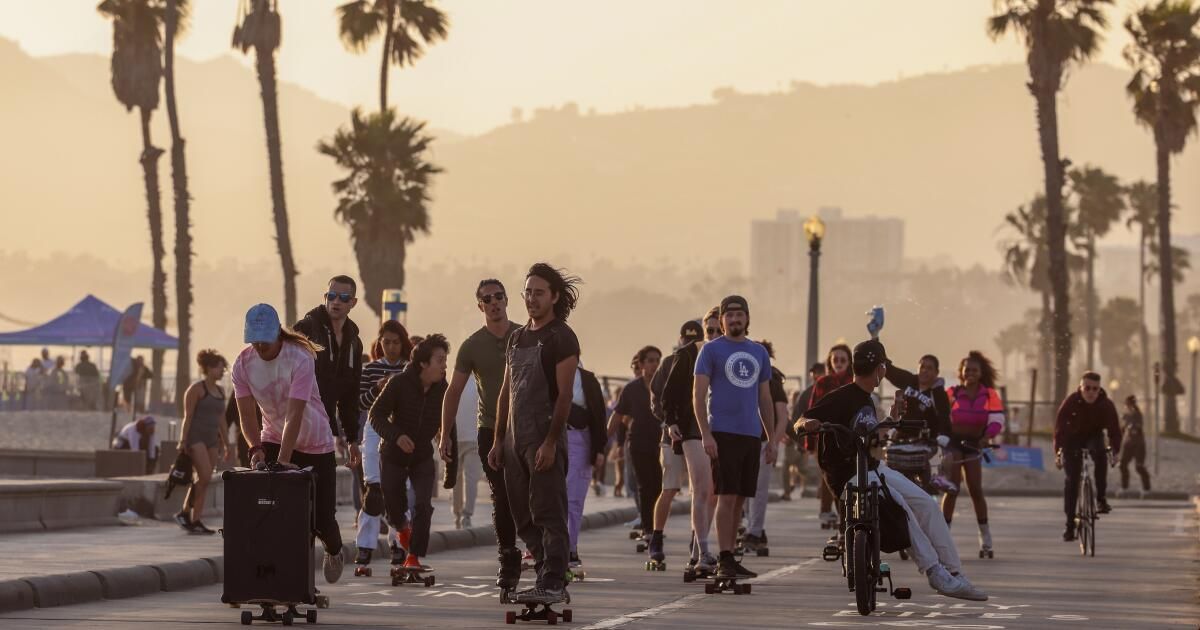New subvariants of COVID-19, collectively dubbed FLiRT, continue to increase their dominance across the country, driving a surge in cases in Los Angeles County and growth in coronavirus levels seen in California wastewater.
Taken together, the data points to a coronavirus resurgence in the Golden State, one that, while not entirely unexpected given trends seen in previous pandemic-era summers, arrived earlier and is being driven by even more strains. transmissible than those observed previously.
However, it is still unclear how serious the COVID situation may become this summer. Doctors have said that by July 4 we may have a better idea of how the rest of the season will play out.
The US Centers for Disease Control and Prevention estimates that the FLiRT subvariants, officially known as KP.3, KP.2 and KP.1.1, represent a combined 62.9% of samples nationwide during the two-week period ending Saturday. That's up from 45.3% a month ago.
Experts say the new subvariants are more contagious than the dominant winter subvariant, JN.1.
California is now one of 15 states with high or very high levels of coronavirus in wastewater, according to the CDC. Those states are generally found in the west and south, as well as New England. In addition to California, they are Alaska, Colorado, Connecticut, Florida, Hawaii, Idaho, Missouri, Nevada, New Hampshire, New Mexico, Tennessee, Texas, Utah and Wyoming.
Coronavirus levels in California wastewater overall have risen sharply since early May, in contrast to national trends, which indicate a slower rise. The latest weekly level of viral activity from California wastewater was near the peak seen last summer.
In Santa Clara County, Northern California's most populous, wastewater levels are considered high across a wide swath of Silicon Valley, from San Jose to Palo Alto.
Coronavirus levels in Los Angeles County wastewater have remained generally stable after rising last month. For the week ending June 8, the most recent available, wastewater levels were at 15% of the winter 2022-23 peak, up from 13% the previous week, but slightly below 16%. from the previous week. It peaked last summer near the end of the season, when wastewater levels were at 38% of the winter 2022-23 peak level.
However, reported cases of COVID-19 continue to increase. During the seven-day period ending June 16, an average of 154 per day were reported in Los Angeles County, up from 121 the previous week. Reported cases are an undercount as they indicate only testing performed at medical facilities and do not include at-home testing. They also don't reflect that far fewer people get COVID tests when they are sick.
The average daily number of people with COVID in Los Angeles County hospitals is also increasing. There was an average of 138 per day during the week ending June 15, up from 126 the week before.
COVID deaths remain stable, at less than one per day, on average, during the week ending May 28.
The percentage of COVID tests at California medical centers returning positive results continues to increase. During the week ending June 17, 7.5% of COVID tests statewide came back positive, well above the 3.1% rate a month ago. Last summer's peak was 13.1%, recorded at the end of August.
In June, the California Department of Public Health updated its guidelines for older adults, “especially those with weakened immune systems.” Authorities urged seniors to stay up to date on their vaccines, seek medication if they contract COVID and consider extra precautions, such as wearing a mask in crowded indoor areas, opening windows and doors to increase ventilation, staying away from sick people, wash your hands frequently and cover coughs and sneezes.
The increases in certain coronavirus tracking data come as the U.S. Food and Drug Administration released new advice for vaccine makers in mid-June. In a June 13 statement, the agency urged manufacturers, if possible, to design this fall's vaccine formulation against KP.2, one of the subvariants of FLiRT, rather than its parent, JN.1. .
The new recommendation overturns guidance from just a week earlier, when the agency had recommended that vaccines be designed against JN.1.
“This change is intended to ensure that COVID-19 vaccines (2024-2025 formulation) more closely match circulating strains of SARS-CoV-2,” the FDA said in a statement, referring to the formal name of the COVID virus. -19.
By this fall, the predominant COVID subvariant “will probably be closer to KP.2 than it would have been, perhaps, to JN.1,” said Dr. Peter Marks, director of the Center for Biologics Evaluation and Research at the FDA, at a press conference on Friday.
The mRNA-based vaccines, made by Pfizer and Moderna, will be able to produce injections this fall for KP.2. But the protein-based vaccine, made by Novavax, will still be designed against JN.1 because manufacturing of the mRNA vaccine can be done more quickly, Marks said.
“What you can do when you make a protein-based vaccine versus an mRNA vaccine is different in terms of the agility to react to what's coming,” Marks said. Still, the difference between receiving a vaccine designed against the newer KP.2 subvariant versus the slightly older JN.1 subvariant likely won't result in “that big of a difference.”
“We're not going to have a preference,” Marks said, in terms of recommending the Pfizer or Moderna vaccine over Novavax. “The best vaccine for this fall season is the one you put in your arm.”
Marks said a vaccine designed against KP.2 “perhaps provides a small benefit” compared to one against JN.1. “Basically, by using the most recent update, we hope to provide protective immunity that lasts longer,” Marks said, into late fall and winter.
“It's like trying to give people the biggest advantage, right? The extra hundredth of a second you gain [a race] with,” Marks said. “But I think the most important thing for people to know is that either way, any of these are perfectly good.”
Federal officials have expressed hope that the COVID vaccine will be available sooner this year than in 2023. Last year's rollout was complicated because the updated COVID vaccine came out slightly later than the seasonal flu vaccines, which which made it more difficult for people to receive both vaccines at the same time. the same visit if they had preferred that.
COVID-19 remains a disease that must be protected against, doctors say. About 45,000 COVID deaths have been reported since Oct. 1 nationwide, and doctors say those most at risk are older and immunocompromised people who have not received an updated vaccine.
“This is not just about disappearing overnight. It’s going around,” Marks said.












